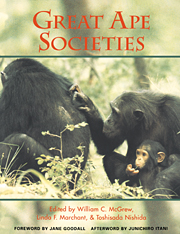Book contents
- Frontmatter
- Contents
- List of contributors
- Preface
- Foreword: conserving great apes
- Part I Apes overviewed
- Part II Social ecology
- Part III Social relations
- 8 Social grouping in Taï chimpanzees
- 9 Coalition strategies among adult male chimpanzees of the Mahale Mountains, Tanzania
- 10 Male rank order and copulation rate in a unit-group of bonobos at Wamba, Zaïre
- 11 Comparing copulations of chimpanzees and bonobos: do females exhibit proceptivity or receptivity?
- Part IV Minds
- Part V Apes compared
- Part VI Modeling ourselves
- Afterword: a new milestone in great ape research
- Appendix: great ape study sites
- Index
11 - Comparing copulations of chimpanzees and bonobos: do females exhibit proceptivity or receptivity?
Published online by Cambridge University Press: 04 August 2010
- Frontmatter
- Contents
- List of contributors
- Preface
- Foreword: conserving great apes
- Part I Apes overviewed
- Part II Social ecology
- Part III Social relations
- 8 Social grouping in Taï chimpanzees
- 9 Coalition strategies among adult male chimpanzees of the Mahale Mountains, Tanzania
- 10 Male rank order and copulation rate in a unit-group of bonobos at Wamba, Zaïre
- 11 Comparing copulations of chimpanzees and bonobos: do females exhibit proceptivity or receptivity?
- Part IV Minds
- Part V Apes compared
- Part VI Modeling ourselves
- Afterword: a new milestone in great ape research
- Appendix: great ape study sites
- Index
Summary
INTRODUCTION
Chimpanzees (Pan troglodytes) and bonobos (P. paniscus) have a similar social structure (patrilineal multi-male and multi-female social unit; Itani, 1985). However, bonobos exhibit quite different copulatory activities from other non-human primates, including chimpanzees: (1) bonobos copulate more often than other anthropoid apes (Kano, 1989); (2) bonobos copulate in varied postures (Savage-Rumbaugh & Wilkerson, 1978); (3) copulationlike behavior often occurs in other social contexts (Kano, 1980; de Waal, 1989); (4) female bonobos exhibit lengthy estrus (Dahl, 1986); (5) suckling mothers resume sexual cycling within a year after giving birth (Kano, 1992). Some authors (e.g. Blount, 1990) have discussed these features in connection with the evolution of the sexuality of human females.
However, how different is the sexual behavior of bonobos from that of chimpanzees in the wild? Here, we compare the copulatory behavior of these two species, based on previous reports and on our field studies.
BACKGROUND
In the Mahale Mountains National Park, Tanzania, the chimpanzees of M group have been observed since 1965. The group contained about 100 individuals in 1981 (see table 3 in Nishida et al., 1990). The adult sex ratio (10 : 39) was significantly skewed toward females compared with the expected ratio of 1 : 1 (Chi-squared = 17.2, df = 1, p < 0.001; for discussion of this tendency, see Hiraiwa-Hasegawa et al., 1984; Nishida et al., 1990).
- Type
- Chapter
- Information
- Great Ape Societies , pp. 146 - 156Publisher: Cambridge University PressPrint publication year: 1996
- 30
- Cited by



